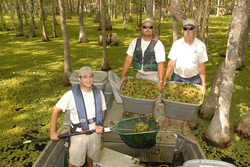 Texas Parks & Wildlife Department representatives remove giant salvinia from B.A. Steinhagen Lake near Jasper. The samples are being used by researchers at SFA's National Center for Pharmaceutical crops to search for possible cancer treatments.
Texas Parks & Wildlife Department representatives remove giant salvinia from B.A. Steinhagen Lake near Jasper. The samples are being used by researchers at SFA's National Center for Pharmaceutical crops to search for possible cancer treatments.A thorn in the side of area boating enthusiasts may provide a ray of hope for some cancer patients, according to recent research findings at SFA's National Center for Pharmaceutical Crops.
Researchers at the center have discovered that giant salvinia, one of the most noxious invasive species in the world, has promising medical potential that could provide a novel approach to controlling the species.
The team recently discovered that extracts of giant salvinia can effectively inhibit the growth of human tumour cells with minimum damage to normal cells. The researchers are also the first to have isolated a class of compounds responsible for the bioactivities.
"Our research opens a new door to positive control of noxious invasive plants," said Dr. Shiyou Li, research professor and director of the center, which is housed in the Arthur Temple College of Forestry and Agriculture at SFA. "Also, our elucidation of the chemical composition of giant salvinia will help researchers better understand the molecular mechanism of invasion."
Giant salvinia, also known as water fern and kariba weed and by its scientific name Salvinia molesta D. S. Mitchell, is a fern species native to Brazil. Since 1939, it has invaded lake and river systems in warm climates. Climate change, particularly increasing temperatures, a longer growing season and rising carbon dioxide levels, have increased both the abundance and diversity of invasive plants. Giant salvinia currently is one of the most widespread and environmentally, economically and socially destructive invasive plant species in the world.
Dense mats of salvinia reduce dissolved oxygen levels and block all sunlight from penetrating the infested water body, causing macrophytes and microscopic algae that form the base of the food chain to die off. The animals that feed on the algae may die, too, and so on, up the food chain. This pest also threatens cultivated aquatic crops, and it can clog irrigation and drinking water lines and foul hydroelectric plants. Salvinia-infested waters cannot be used for boating or other recreational purposes.
Part of the NCPC project is funded by the National Institute of Food and Agriculture of the U.S. Department of Agriculture. Dr. Li is the principal investigator, while Drs. Ping Wang, Guangrui Deng and Wei Yuan participated in the research and were responsible for the primary isolation of the compounds.
The Texas Parks and Wildlife Department has collected about 1,000 pounds of plant matter in East Texas for use in the study. To date, more than 30 different compounds, including four new compounds, have been isolated from the giant salvinia. Further tests of the bioactive compounds isolated from giant salvinia are ongoing in Dr. Bharat B. Aggarwal's lab in M.D. Anderson Cancer Center in Houston.
"Dr. Li and I have been discussing all the results we have jointly obtained with this plant, and it is looking extremely promising," said Aggarwal, a professor in the Department of Experimental Therapeutics, Division of Cancer Medicine, at M.D. Anderson.
"We are very excited about the potential that exists with it, especially in the area of cancer, and I am very optimistic about what could result from this collaboration."
Aggarwal added that securing funding for the continuing research is the biggest obstacle for the researchers to overcome in the short term. "Without funding, we can only do so much. So, that is going to be one of the limiting factors."
Dr. Steven H. Bullard, dean of the Arthur Temple College of Forestry and Agriculture, said pioneer studies at the NCPC have made SFA an international leader in researching pharmaceutical crops.
"In the last several years, the center has dedicated its research to identifying novel anticancer and antiviral agents from native plants in Texas and noxious invasive species and to securing national strategic pharmaceuticals," he said. "The team has tested 1,200 plant species native to Texas and isolated more than 600 compounds, including 106 new structures."
Li and his colleagues at National Cancer Institute, M.D. Anderson Cancer Center, New York Botanical Garden and University of Puerto Rico have developed the concept and principle of pharmaceutical crops. With the support of a team of international leading scientists, most recently, they launched Pharmaceutical Crops, the only international peer-review journal in the field, with Bentham Science Publishers.
 Axe ’Em, Jacks!
Axe ’Em, Jacks!